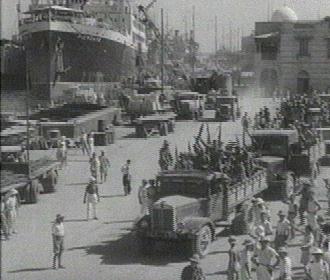 Early Colonial Eritrea
(mid 1800s - mid 1900s)
Early Colonial Eritrea
(mid 1800s - mid 1900s)  Early Colonial Eritrea
(mid 1800s - mid 1900s)
Early Colonial Eritrea
(mid 1800s - mid 1900s)
The origins of the people of Eritrea lie far back in time. These residents emerged during the 19th century as a group of independent chiefdoms and clans. Being located along the Red Sea allowed for trade with others around the Red Sea region. They also concentrated their trading efforts with the Tigrayan and Amharic neighbors to their west.
The definition of their country as Eritrea, with its frontiers, derived from the imperial partnership and rivalry of two expansionist powers late in the 19th century, Ethiopia and Italy (Davidson, 11). Italian colonialism wasn’t quick to start. Stifled with problems within their own country, Italy’s economic stance was regelating itself backward, it was relatively new as a single united country, and Britain and France dominated much of the landscape. There were many people within Italy that didn’t support colonial adventures and the banking system was pessimistic about funding such adventures. These all conspired to Italy’s slow start, but this didn’t last for long.
Italy’s first colonialization in the Horn of Africa was actually in 1885 when an Italian force occupied the port of Massawa. They were able to do this through backing from Britain. The British thought it would be convenient to have a partner in colonialism, just as they had Portugal as a partner on the western side of Africa.
Having this land, the Italians then began to push inland, but did not find this to be easy due to Eritrean armed fighters. However, the Italians were not giving up, and eventually pushed inland. As they continued this push, the Italians ran into more trouble, that being the imperialist Amharic Ethiopia. The Italian government wanted to establish a coastal colony as well as extend Italian protection. This all occurred during Menelik’s (the builder of the modern Ethiopian tribe) rise to power. However, Menelik was not in charge of the land because Emperor John was on the throne. Crispi (the Italian government) persuaded Menelik to support their conquest and he would provide Menelik with aid in the form of armed soldiers. Menelik obtained the throne in March of 1889 when Emperor John fell in battle and the Italians were able to secure a treaty of friendship and alliance.
After securing the treaty, the Italians rapidly took over land despite continued Eritrean resistance. This was not pleasing for Menelik as he now began to see that the Italians had played him into a trick. He declared the treaty unjust holding that "the Italian version which gave Italy a protectorate over Ethiopia was null and void, since it did not appear in the Amharic version and he, Menelik, had not agreed to it." The Italians, however, pressed onward underestimating Menelik’s military and political strength. This led to their "great military disaster at Adua in 1896, when more Italians were killed in one day than in all the battles for the unification of Italy itself" (Davidson, 12).
This defeat led to Italy’s consolidation of their colony of Eritreans due to Menelik forgoing his desires in that country. He later signed peace with Italy a few months after the battle of Adua (October 1896). Eritrean resistance gradually came to a halt and the Italian colony of Eritrea lasted from 1890 until 1941. The Eritreans had mixed feelings about Italian control. Some thought they were robbed of their independence and were subject to foreign rule and culture while their own culture and identity were being denied to them. However, many believed that "the fact of living together within frontiers which were now defined as those of a separate entity, Eritrea, gave them a new sense of common fate and of incipient nationhood" (Davidson, 12).
Italian armies began invading Ethiopia in 1935. The Ethiopian resistance was long , but failed due to not requesting foreign aid. Italy proclaimed possession of the Ethiopian empire in May 1936.
Formerly under Italian control, Eritrea was taken over by Britain during World War II and was a British protectorate from 1941 until 1952, when it was federated with Ethiopia. World War II was the turning point for Italian control over Eritrea. Italian forces were numerous in East Africa, "some 300,000 under arms," but British armies were able to sweep Italian rule altogether in the region. The British government returned Ethiopia to their empire and Eritrea was placed under a British administration. They promised the Eritreans that they would never be subject to Italian rule again.
Sources
Davidson, Basil, et al. Behind the War in Eritrea. Russell Press Ltd., Nottingham, 1980.
Ghebre-Ab, Habtu. Ethiopia and Eritrea. The Red Sea Press. Trenton, NJ. 1993.
Haile, Bocresion. The Collusion on Eritrea. No publisher / city given. 2000.